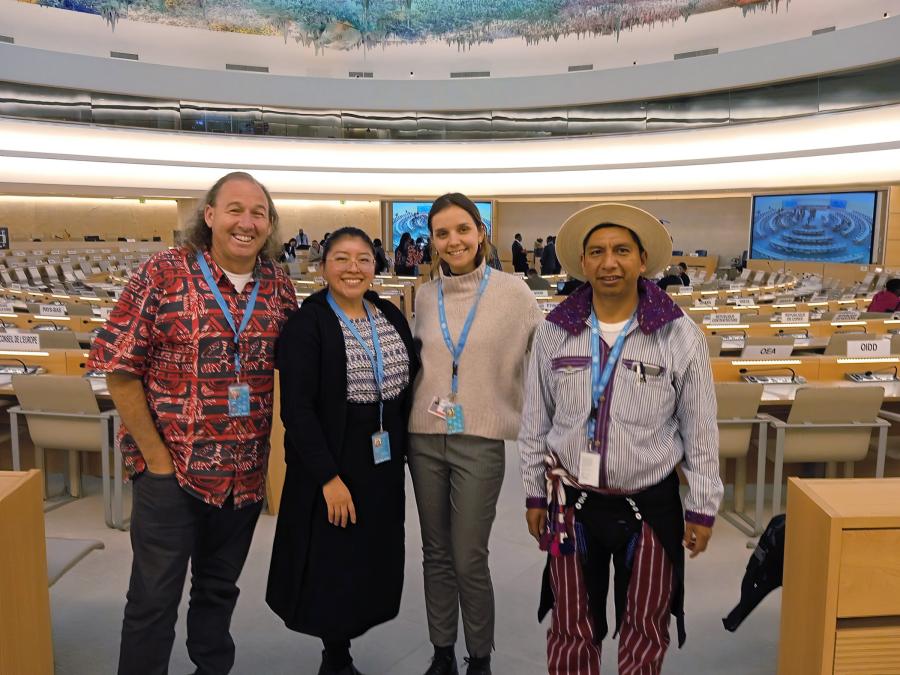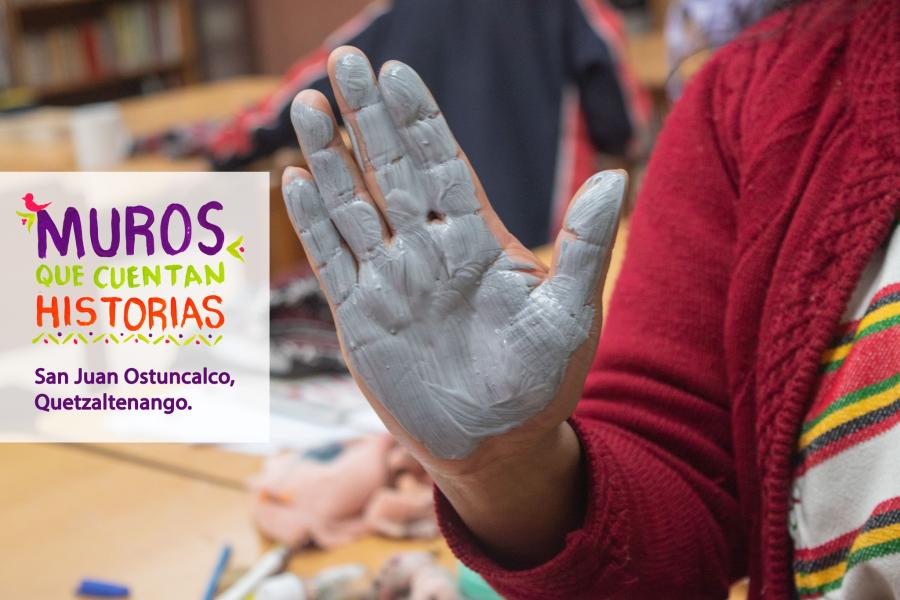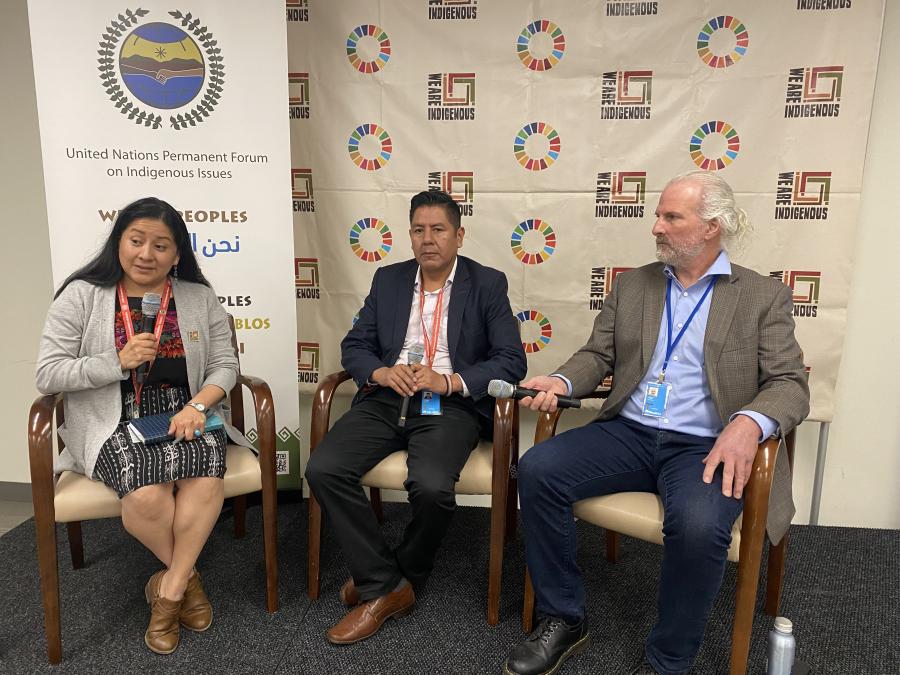A Guatemala fair trade weaving cooperative enables civil war widows to stay home and maintain their Mayan culture, but the coop struggles to survive in the global marketplace.
In the 1980s the women of Guatemala’s department of Sololá, in the Canton Pujujil region on the edge of Lake Atitlán, watched as their community slowly disintegrated under the pressures of the country’s decades-long civil war. Most of these women were widows, and many had already been forced to move to the city or to send their children to the city to find jobs in order to support their families. Fearful that they would soon lose their Mayan language, culture, and community cohesiveness, a group of widows decided to use one Mayan tradition, back strap weaving, to provide a sustainable income without leaving home.
The women founded a weaving cooperative in 1985. In 1987, with the help of Canadian businessman Ron Spector, the women created Asociación Maya. The organization was active in the alternative trade organization movement, and later joined the Fair Trade Federation (FTF). The association no longer pays its dues to FTF, but its textiles are marketed as “fairly traded” in North America and Europe.
From February through May 2005, Cultural Survival interviewed 10 members of Asociación Maya who weave in their homes in the neighborhood of El Triunfo, as well as members of the cooperative’s leadership, at its main offices in the departmental capital city Sololá. We also spoke with some of the association’s staff members, who work as dyers, cutters, and tailors. The members, many of whom still live in poverty, said the association had improved their lives and that they were grateful for the opportunity to make a living without leaving their community. Some regretted the creative control they lost by putting their traditional work on the global market, but most agreed that their top priority was to secure sales for their goods.
In many ways, the fair trade crafts industry is different from the fair trade coffee industry. While the basic principles of paying a fair price, treating workers well, and protecting the environment apply, the absence of a structured commodities pricing system has left the definition of “fair” up to interpretation for crafts producers in the South and traders in the North. According to Mary Ann Littrell and Marsha Ann Dickson in Social Responsibility in the Global Market, those who are involved with fair trade of crafts should “consider [the] effects of their decisions on whether: natural resources and cultural traditions are preserved; workplaces are safe and conducive to the interpersonal exchange of opinions; workers are paid fairly so they can meet daily subsistence needs, educate their children, care for family health, and contribute to community growth; and artisan enterprises are sustainable across time and as customer preferences change.” Littrell and Dickson also discuss monitoring and improving product quality, offering business and technical expertise and opportunities for worker advancement, and building long-term trade relationships as key aspects of fair trade ideology.
Asociación Maya’s members’ experiences illustrate tensions that can arise, even under the fair trade system, when indigenous peoples decide to use their cultures to sustain their economies.
The association operates out of several sites in Canton Pujujil. Spector’s role has been mostly that of adviser; he instructs the coop members and employees in product development and provides global contacts for them. As a link with the North American market, he consults with the association on colors and designs that will sell well. The women respect and appreciate Spector’s ongoing support and say that the work they do through the association has helped them support their families and rebuild their lives since the end of Guatemala’s 36-year civil war.
Rosario Yaxon Cumes, a weaver, said her work for the association allows her to care for her children: “I am a widow of the violence in 1981 and 1982. For this reason, I am very dependent on the cooperative,” she said. “The problem is that there is not much demand for the work.”
Asociación Maya has strict rules to govern membership. A person cannot join the cooperative as a member unless they are from Canton Pujujil (comprised of five neighborhoods—El Progreso, La Pochol, El Triunfo, del Adelante, and La Fe). Men are prohibited from becoming members. The number of new members admitted each year is determined by the amount of work the cooperative has. With 208 members, the cooperative has put a hold on new memberships until production needs increase.
Three people are on the association’s payroll and receive a year-round wage in addition to money deposited into social security-type accounts. Staff members are paid Guatemala’s legal minimum wage, totalling about 19,000 quetzales (U.S. $2,500) per year—a high income for artisans in Guatemala, Spector said. Others are hired on an as-needed basis and receive only wages for their work. Asociación Maya has a strict division of labor: except for the three permanent employees who serve in a number of capacities, jobs are defined by tasks. Often a seasonal employee is only trained in one particular skill. Two to three women dye materials, another two wind and count the fibers, and a few others measure dry dyes according to color formulas. Men are allowed to be employed by the association.
The cooperative dyes, weaves, and sells garments such as vests and scarves, as well as change purses, shoulder bags and other accessories. All of this work is made from chenille and cotton fibers and dyes the cooperative purchases from stores in Miami, Florida. The association’s departure in 1998 from more traditional cotton weaving fibers resulted from suggestions from Spector to use materials that would sell better in North American and European markets.
Two employees who work primarily at the association’s main offices oversee the types and colors of items woven. The dyed fibers are packaged according to color scheme and design. The amount and size of the fibers are calculated according to the type of item to be woven. These packages are then delivered to the weavers in Canton Pujujil, who use the materials and the pre-determined design to make scarves or pieces of jackets or bags. When the weavers are finished, they sell the cloth back to the association, where staff members cut and sew it into final products.
The association is managed by a five-member junta directiva elected every two years from the cooperative’s membership. The junta approves all major decisions that affect the cooperative. For the first time, association members in 2005 reelected a junta directiva to a second term.
“No one speaks openly about wanting to serve on the board, but last year most of the board [junta] did want to continue to serve, which is odd because it’s a lot of work,” Spector said. “It shows that people could work together and weren’t totally frustrated. Because there was a profit last year, people mostly felt comfortable with the work the junta had been doing.”
Weavers told Cultural Survival that they were happy with the work the current junta had done, and that they represented weavers’ interests. The junta’s decisions often revolve around what items and designs the cooperative members will produce.
“The challenge is making a product using that cultural heritage, the backstrap weaving, that is going to actually sell,” Spector said. “The whole idea of traditional colors, traditional patterns—within every culture there’s change according to the marketplace, based on traditional ideas.” The bright pinks, lime greens, and oranges that are fashionable today in Mayan communities (and which the association members use to weave textiles for their own clothing) do not sell well in North American and European markets, which prefer deeper and richer blends, Spector said.
When Spector sends color instructions to Asociación Maya, the association determines how to combine those colors. The cooperative’s production process is unique, Spector says, because its management and members have some say in the final appearance of the design. More commonly, crafts cooperatives that partner with Northern companies and organizations receive strict instructions on the specific designs and color combinations they must use to fulfill an order. The freedom that the Asociación Maya management has in combining colors sometimes surprises Spector when he receives a shipment of completed textiles woven in unexpected color combinations, he says.
“Any successful business is based on the Northern partner providing the design expertise,” Spector said. “There is no way a producer group [in Guatemala] is going to come up with something out of their own head that’s going to be right for the market in the North.”
Over the past two decades, when Spector encouraged the association to play a larger role in the design process, their input generally was in a direction the marketplace would not support, Spector said. Many of the association members Cultural Survival interviewed said they would rather leave design matters to Spector if it means they will be able to sell more of their work and make a living. Some, however, did express their desire to have more control over the design.
Economic Sustainability and Cultural Preservation
Even with special attention to the North American and European market, the association struggles to find a large market. Unlike the fair trade coffee market, in which cooperatives are meant to stabilize the market and help assure a steady income, Asociación Maya offers weavers a higher price for their work but not a guarantee that their work will sell.
Weavers are paid per-piece when they deliver a finished textile to the association office. One textile, such as a scarf, or piece of a bag or jacket, can be completed in as little as three days. But the weavers face other daily demands, such as caring for children, maintaining the household, and preparing meals.
The weavers we interviewed said they were typically able to weave one textile in two to three weeks. Depending on the size of the textile, they receive 15 quetzales (about US $2) to 80 quetzales (about US $11). On average weavers make about US$150 to $200 per year. But weavers are not provided with any wages other than for the items they produce. For widows, who do not have husbands also earning an income, the money they make is rarely enough.
El Triunfo, where most of the association’s weavers live, is far from the city, said weaver Petrona Yazón Zep, so the food and household needs that are available locally are expensive. The income from weaving barely covers these costs. But the money the weavers make is better than any alternative. According to Spector, without the association, the women would be weaving textiles for local use at a third of the income, or would have to move to the city for other poorly paid work.
“It’s not enough, but it’s something,” said weaver Juana Ajcalón Ajcalón about her earnings through the association.
A particular challenge for Asociación Maya, according to its leadership and many of the members Cultural Survival interviewed, is that the organization has no steady market in which to sell its work. Pieces are sold in two area tourist towns: a several-hour drive away in Antigua, through an establishment infamous for its high prices, and 3,000 feet down the hill in Panajachel, the primary tourist town in the Lake Atitlán region. None of the woven items are sold in Canton Pujujil. The association also sells weavings internationally, mostly through its connections with Spector. But that market is small and intermittent, he says. For example, for a jacket, Spector will pay the association about $55. Shipping and duty fees cost an extra $20. Marketing, office expenses, and booth fees at the events where Spector typically sells the jackets, plus an 18 percent markup (considered a reasonable markup in the industry) bring the retail price for the jacket to nearly $125.
“How do I sell that jacket in the marketplace where nobody knows it took five days to make?” Spector asked. “Even those who do, find it hard to grasp what five-days labor means. The price I can ask for that jacket is still relatively limited by the marketplace.”
An incongruity also exists between the desire to preserve the 3,000-year-old tradition of backstrap weaving and the technique’s inefficiency when producing for a mass market. Backstraps have been replaced by footlooms in most parts of the world. Because the footloom has a larger frame, its users can produce a wider variety of textiles more quickly. This reduces production costs and allows retailers to charge lower prices, while maintaining or improving the per-piece income of the weaver. But while weavers say their primary interest in the weaving cooperative is to make more money for their families, they have been hesitant to adopt the new technology. Before the cooperative restructured as Asociación Maya, Spector said, a local non-governmental organization trained members to use footlooms. But when the new looms were brought to the community, they sat idle for nearly 10 years before they were moved elsewhere. A division of labor along gender lines exists in Guatemala: in almost all communities, men use the footlooms and women use the backstraps. For women to break this tradition in order to increase their income would require a major cultural shift.
Unsteady sales and insufficient demand pose significant production surplus and income problems for the cooperative, junta members said. During the off-peak season, the association has had to lay off some of its staff. At times the supply room for the cooperative is overflowing with items that have not sold. The president of the association said Asociación Maya has no surplus income once it pays its $400-per-month rent for the two small buildings it occupies in Sololá, and covers the transportation costs for the delivery of materials to weavers, the purchase of dyes and fibers, the acquisition and maintenance of sewing equipment, and employee wages.
Despite the hardships the association faces and the market instability the weavers experience, Asociación Maya has allowed the communities of Canton Pujujil to stay together during the final years of the civil war and the first crucial years of peace. The association members have chosen to allow some aspects of their traditional weaving practices to evolve according to world market demand in order to save others. More importantly, their production for the world market has allowed them to avoid even more poorly paid work and to maintain their families, languages, and livelihoods in a way that could never be replicated in a city.
Jennifer Wilhoit is the founder and director of TealArbor, Education and Research for Crafts Communities and the Environment. She is an avid collector of textiles in Guatemala and globally and visited Asociación Maya in May. Tara Tidwell Cullen is the managing editor of publications for Cultural Survival. Special thanks are due to members of the Sololá-based Nuitzij Womens Media Colelctive and University of Illinois anthropologist Tim Smith, who assisted in the field work for this article.
Reference and further reading
Littrell, M. & Dickson, M. (1999). Social responsibility in the global market. Thousand Oaks, CA: Sage Publications.



